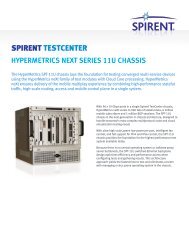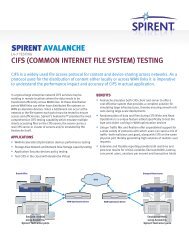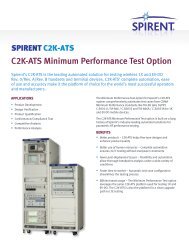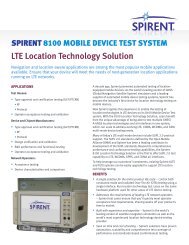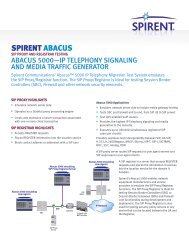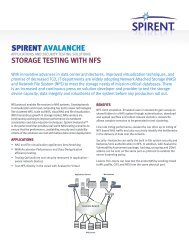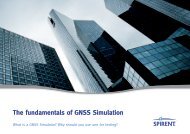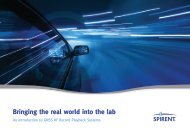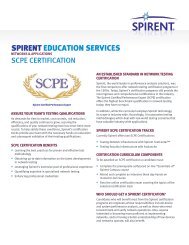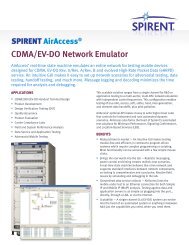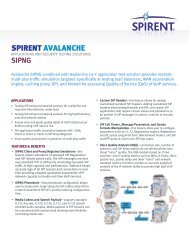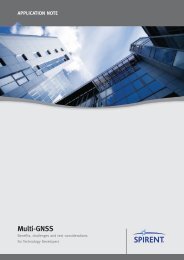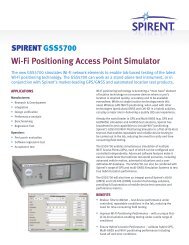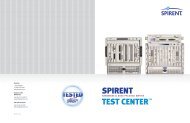The risks and limitations of GNSS live sky testing within a production ...
The risks and limitations of GNSS live sky testing within a production ...
The risks and limitations of GNSS live sky testing within a production ...
You also want an ePaper? Increase the reach of your titles
YUMPU automatically turns print PDFs into web optimized ePapers that Google loves.
<strong>The</strong> <strong>risks</strong> <strong>and</strong> <strong>limitations</strong><br />
<strong>of</strong> <strong>GNSS</strong> <strong>live</strong> <strong>sky</strong> <strong>testing</strong><br />
<strong>within</strong> a <strong>production</strong> environment
Challenges for the unfamiliar<br />
<strong>The</strong> addition <strong>of</strong> location awareness to all manner <strong>of</strong> high-volume<br />
consumer products brings with it a number <strong>of</strong> challenges for<br />
manufacturers that are not necessarily familiar with satellite<br />
navigation technology.<br />
And these challenges do not end once the product is designed <strong>and</strong><br />
debugged.<br />
When the product moves into <strong>production</strong>, the challenge becomes<br />
how to ensure that every single unit leaving the factory will perform<br />
exactly as it should. Because any malfunctioning location aware<br />
product will very quickly be found out ¬– as soon as it gives its users<br />
an inaccurate fix on their position, or de<strong>live</strong>rs navigation instructions<br />
that are patently wrong.<br />
SPIRENT eBook<br />
Page 2
Manufacturers <strong>of</strong> consumer products<br />
<strong>The</strong> dangers from cars to mobile h<strong>and</strong>sets have<br />
become all too aware <strong>of</strong> the power <strong>of</strong><br />
<strong>of</strong> failure the disgruntled user. Online forums<br />
<strong>and</strong> today’s social media provide the<br />
dissatisfied customer with the means to tell the world that any given<br />
product does not do “exactly what it says on the tin”.<br />
And while such media can <strong>of</strong>fer valuable opportunities to improve<br />
customer interaction, recurring negative comment can do irreparable<br />
damage to any br<strong>and</strong>’s reputation for reliability.<br />
SPIRENT eBook<br />
Page 3
Quality control<br />
Clearly, the only way to ensure that products released to the market<br />
are fit for purpose is through functional <strong>testing</strong> at the end <strong>of</strong> the<br />
<strong>production</strong> line. And in this respect, the <strong>GNSS</strong> receiver is no different<br />
from any other function <strong>of</strong> the end equipment.<br />
<strong>The</strong> challenge then becomes how best to integrate functional <strong>testing</strong><br />
<strong>of</strong> the <strong>GNSS</strong> receiver with the other tests performed on the product.<br />
And that means devising a test strategy that will exercise the<br />
equipment sufficiently to prove its correct (or incorrect) functionality<br />
in the minimum possible test time.<br />
SPIRENT eBook<br />
Page 4
Functional <strong>testing</strong><br />
As with any functional <strong>testing</strong>, the operation will involve applying a<br />
known stimulus <strong>and</strong> observing the response. If the response is <strong>within</strong><br />
acceptable bounds the product passes the test; if the response is<br />
outside those bounds the product fails.<br />
<strong>The</strong> response to the stimulus may simply be a trigger signal or an<br />
alarm, or it may be some variable output that can be measured for<br />
the purposes <strong>of</strong> the test. But whatever the expected result, it is<br />
essential that the stimulus is accurate <strong>and</strong> repeatable so that the<br />
response can be gauged against a known st<strong>and</strong>ard.<br />
SPIRENT eBook<br />
Page 5
<strong>The</strong> tests required<br />
<strong>The</strong> exact tests required will depend entirely on the intended<br />
use <strong>of</strong> the end equipment. And while it will not be necessary to<br />
exercise all the functions <strong>of</strong> the <strong>GNSS</strong> receiver, the tests need to<br />
ensure that the receiver will function as required when it is<br />
used “in anger”.<br />
So while static navigational accuracy may well be the simplest<br />
test to perform, other aspects such as time to first fix (TTFF)<br />
or re-acquisition time might well be important to the overall<br />
operation <strong>of</strong> the equipment.<br />
SPIRENT eBook<br />
Page 6
Supplying the stimulus<br />
When integrating <strong>GNSS</strong> tests with other acceptance tests, the first<br />
(<strong>and</strong> rather obvious) problem is that the test area is not exactly<br />
a <strong>GNSS</strong> friendly environment. <strong>The</strong> ro<strong>of</strong> <strong>of</strong> the <strong>production</strong> area will<br />
almost certainly block the ingress <strong>of</strong> signals from any <strong>GNSS</strong> system,<br />
<strong>and</strong> there will inevitably be a great number <strong>of</strong> interfering RF signals<br />
being reflected around the test area.<br />
<strong>The</strong> first <strong>of</strong> these problems is relatively easy to solve: the <strong>GNSS</strong><br />
signals can be “captured” by an outdoor receiver <strong>and</strong> relayed to the<br />
test area. However, while relaying “<strong>live</strong>-<strong>sky</strong>” signals might seem to<br />
<strong>of</strong>fer a cost-effective solution for <strong>production</strong> <strong>testing</strong> <strong>of</strong> <strong>GNSS</strong>-enabled<br />
equipment, it does have many significant <strong>limitations</strong>.<br />
SPIRENT eBook<br />
Page 7
<strong>The</strong> <strong>limitations</strong> <strong>of</strong> <strong>live</strong> <strong>sky</strong> <strong>testing</strong><br />
Live <strong>sky</strong> <strong>testing</strong> describes a scenario where the RF signals being sent<br />
to the GPS receiver in the test system are from navigation satellites<br />
overhead at that time. <strong>The</strong> antenna which is receiving the signals from<br />
space is connected to the GPS receiver by cable or Bluetooth <strong>and</strong> is<br />
typically mounted on the ro<strong>of</strong> <strong>of</strong> a building or fitted to a test platform<br />
such as a motor vehicle, train, ship or aircraft.<br />
{Simple diagram here}<br />
SPIRENT eBook<br />
Page 8
If using a test platform (e.g. an aircraft) <strong>live</strong> <strong>sky</strong> <strong>testing</strong> allows insitu<br />
analysis <strong>of</strong> system performance including elements such as<br />
antenna placement <strong>and</strong> electronic interference. In addition, by<br />
using splitters <strong>and</strong> attenuators a single GPS antenna, mounted<br />
for example on the ro<strong>of</strong> <strong>of</strong> a building, can feed multiple test<br />
rigs. This simplicity <strong>of</strong> installation <strong>and</strong> operation, which can<br />
easily be achieved by GPS novices, is the main reason why some<br />
organizations initially choose this method.<br />
SPIRENT eBook Page 9
However, for those requiring a rigorous GPS test environment,<br />
<strong>live</strong> <strong>sky</strong> <strong>testing</strong> has some serious <strong>limitations</strong> including a lack <strong>of</strong><br />
repeatability, control <strong>and</strong> scalability. Depending on the application,<br />
it can also turn out to be a resource intensive test method with<br />
potentially negative impacts on time to market, development <strong>and</strong><br />
support costs. <strong>The</strong>re is also the issue that in some countries reradiation<br />
<strong>of</strong> <strong>GNSS</strong> signals is illegal.<br />
SPIRENT eBook Page 10
Repeatability<br />
By definition, <strong>live</strong> <strong>sky</strong> <strong>testing</strong> is not a repeatable test method<br />
because the GPS constellation constantly changes. For example,<br />
if using a static antenna the dilution <strong>of</strong> precision (DOP) <strong>of</strong> the<br />
navigation solution will be observed to vary as satellite azimuths,<br />
elevations <strong>and</strong> signal strengths change. When using a GPS receiver<br />
on a moving test platform additional variables are introduced such<br />
as the slew, pitch <strong>and</strong> yaw <strong>of</strong> the GPS antenna relative to the<br />
satellites along with signal attenuation, reflection <strong>and</strong> refraction<br />
from overhanging trees, adjacent buildings etc.<br />
What all this means in practice is that the GPS conditions causing<br />
an error during one test run cannot be reliably <strong>and</strong> repeatedly<br />
replicated during subsequent <strong>live</strong> <strong>sky</strong> <strong>testing</strong> runs.<br />
SPIRENT eBook<br />
Page 11
One technique to overcome this serious limitation to <strong>live</strong> <strong>sky</strong> <strong>testing</strong><br />
is recording the GPS data during the first test <strong>and</strong> replaying the same<br />
GPS data in the lab for subsequent tests. This does allow a measure<br />
<strong>of</strong> repeatability to be introduced to the <strong>testing</strong> regime but does not<br />
however resolve the issue <strong>of</strong> control.<br />
SPIRENT eBook Page 12
Control<br />
Recording <strong>and</strong> replaying GPS data to a test system allows you to<br />
replicate the symptoms <strong>of</strong> an error, for example a position jump, but<br />
it doesn’t give you an answer regarding the root cause<br />
<strong>of</strong> the problem. Was it the introduction <strong>of</strong> a<br />
particular satellite to the solution? Was it<br />
caused by multi-path or signal blockage in<br />
a particular direction? Does it happen under<br />
any ionospheric conditions or only the<br />
conditions occurring at the time the data<br />
was collected?<br />
SPIRENT eBook
Only a simulator <strong>of</strong>fers full control over all relevant GPS variables,<br />
facilitating a test regime which can isolate the root cause <strong>of</strong> GPS<br />
induced errors. A simulator also allows hypothetical scenarios to be<br />
created <strong>and</strong> can consistently create signal errors <strong>and</strong> events (e.g.<br />
RAIM) which may only occur sporadically or r<strong>and</strong>omly in the realworld.<br />
Finally, unlike <strong>live</strong> <strong>sky</strong> <strong>testing</strong> or record <strong>and</strong> replay, simulators<br />
are a fully scalable <strong>testing</strong> solution.<br />
SPIRENT eBook Page 14
Scalability<br />
Live <strong>sky</strong> <strong>testing</strong> lacks scalability in three important respects. First,<br />
it does not adequately test products for global markets; second,<br />
it cannot test for future signals <strong>and</strong> satellites, <strong>and</strong>; third, it is not<br />
suitable for a test regime or test st<strong>and</strong>ards applied across multiple<br />
development sites.<br />
Live <strong>sky</strong> <strong>testing</strong> is based on a single scenario (the constellation <strong>and</strong><br />
environment at the time <strong>of</strong> the test) <strong>and</strong> a single location. A single<br />
scenario <strong>and</strong> location can never reflect the diversity <strong>of</strong> conditions in<br />
which a GPS system or application may have to operate.<br />
SPIRENT eBook<br />
Page 15
<strong>The</strong> alternative is multiple <strong>live</strong> <strong>sky</strong> tests based on different<br />
constellations (e.g. high DOP versus low DOP), environments (e.g.<br />
urban, rural, forest) <strong>and</strong> locations (e.g. high latitudes, equatorial),<br />
however, as discussed later, this approach has its own set <strong>of</strong> issues in<br />
terms <strong>of</strong> time to market <strong>and</strong> costs <strong>of</strong>ten making it impractical.<br />
GPS is one <strong>of</strong> the six Global Navigation Satellite Systems (<strong>GNSS</strong>)<br />
<strong>and</strong> four Satellite Based Augmentation Systems (SBAS) which will<br />
be available by the middle <strong>of</strong> this decade. <strong>The</strong>re are already over 60<br />
<strong>GNSS</strong> <strong>and</strong> SBAS satellites in operation (including 32 from GPS) <strong>and</strong><br />
more than 130 are planned. <strong>GNSS</strong> incorporates both the existing GPS<br />
L1 <strong>and</strong> L2 frequencies along with L5, L2C, E1, E2, E5a, E5b, E6 <strong>and</strong><br />
many more. Systems tested today using <strong>live</strong> <strong>sky</strong> methods therefore<br />
have a real risk <strong>of</strong> unexpected errors as the full <strong>GNSS</strong> constellation<br />
comes online.<br />
SPIRENT eBook Page 16
Finally, if the requirement is to introduce a common <strong>testing</strong> regime<br />
across multiple development sites (which might be on different<br />
continents) <strong>live</strong> <strong>sky</strong> <strong>testing</strong> does not de<strong>live</strong>r a st<strong>and</strong>ardized<br />
method. Recorded data could be used as a st<strong>and</strong>ard but this still<br />
leaves problems with control (discussed earlier), time to market,<br />
development <strong>and</strong> support costs.<br />
SPIRENT eBook Page 17
Time to market, development <strong>and</strong><br />
support costs<br />
As discussed earlier, the apparent ease <strong>of</strong> setup <strong>and</strong> low cost <strong>of</strong><br />
<strong>live</strong> <strong>sky</strong> <strong>testing</strong> can initially be attractive to organizations seeking to<br />
establish a GPS <strong>testing</strong> regime. However, more <strong>of</strong>ten than not, people<br />
going down this route have not calculated the true costs.<br />
Consider for example how many scenarios <strong>and</strong> locations are required<br />
to adequately test a GPS system. If we assume that we need ten<br />
scenarios at six locations that would require no less than sixty (60)<br />
<strong>live</strong> <strong>sky</strong> tests - each consuming time, engineering resources <strong>and</strong><br />
expense. Even if the test platform was as simple as a motor vehicle<br />
the total costs <strong>of</strong> running sixty <strong>live</strong> <strong>sky</strong> tests could easily run into tens<br />
<strong>of</strong> thous<strong>and</strong>s <strong>of</strong> dollars.<br />
SPIRENT eBook<br />
Page 18
What’s more, even if the data is recorded for future replay (which<br />
helps justify the cost) it has a limited shelf life. For as soon as a<br />
new satellite or frequency is launched (e.g. L5 on GPS IIF satellites)<br />
historic data technically becomes redundant <strong>and</strong> new data should be<br />
collected.<br />
Even with the best <strong>of</strong> planning, as the development process unfolds<br />
it is likely that additional scenarios <strong>and</strong>/or locations will be required.<br />
Each time this happens it not only increases costs but can add<br />
unanticipated delays as resources have to be shifted <strong>and</strong> time found<br />
to collect new data.<br />
SPIRENT eBook Page 19
A similar situation is found during beta <strong>testing</strong> <strong>and</strong> after product<br />
release. A customer problem involving a new scenario <strong>and</strong>/or location<br />
may require yet more data to be collected to adequately analyze <strong>and</strong><br />
resolve the issue.<br />
As these simple examples demonstrate, depending on the volumes<br />
<strong>and</strong> geographic spread <strong>of</strong> markets the GPS or <strong>GNSS</strong> product is<br />
destined for, <strong>live</strong> <strong>sky</strong> <strong>testing</strong> can turn out to be a much more<br />
expensive option than people first think.<br />
SPIRENT eBook Page 20
Don’t be fooled<br />
Certainly, if the only test required is for the equipment to recognise<br />
the presence <strong>of</strong> <strong>GNSS</strong> signals, then the relayed signals would be<br />
adequate for this purpose. Similarly, if the object <strong>of</strong> the test is for the<br />
equipment to determine its location from the signals supplied, then<br />
the relayed <strong>live</strong>-<strong>sky</strong> signals will suffice.<br />
SPIRENT eBook<br />
Page 21
However, the whole ethos <strong>of</strong> quality control is to determine whether<br />
the equipment produces the expected response to a known stimulus.<br />
Certainly, the location <strong>of</strong> the test rig will not change, <strong>and</strong> so the<br />
position calculated by the <strong>GNSS</strong> receiver should always be the same.<br />
But the nature <strong>of</strong> the “<strong>live</strong>” signals that are being relayed will be<br />
changing constantly. <strong>The</strong> relative positions <strong>of</strong> the satellites <strong>within</strong> the<br />
constellation will change; the atmospheric conditions will never be<br />
constant; <strong>and</strong> other external influences such as interference will not<br />
be consistent. So much for applying a “known” stimulus!<br />
SPIRENT eBook Page 22
<strong>The</strong> initial attraction <strong>of</strong> <strong>live</strong> <strong>sky</strong> <strong>testing</strong> is the ease <strong>and</strong> cost <strong>of</strong><br />
setup. However, as we have demonstrated above, this method has<br />
serious <strong>limitations</strong> in terms <strong>of</strong> repeatability, control, scalability, time<br />
to market, product development costs <strong>and</strong> product support costs.<br />
Although the record <strong>and</strong> replay method overcomes some <strong>of</strong> these<br />
<strong>limitations</strong> it cannot provide the rigorous test regime that a <strong>GNSS</strong><br />
simulator can <strong>of</strong>fer.<br />
SPIRENT eBook Page 23
<strong>The</strong> reliable alternative<br />
A <strong>GNSS</strong> simulator provides the ideal alternative to any form <strong>of</strong> “<strong>live</strong>”<br />
signals for <strong>testing</strong> any <strong>GNSS</strong> receiver. And while the simulator that<br />
would typically be used in characterising the design would need to<br />
be a fully-featured multichannel instrument capable <strong>of</strong> simulating the<br />
signals <strong>of</strong> an entire constellation <strong>of</strong> satellites, the simulator used for<br />
<strong>production</strong> <strong>testing</strong> can be a relatively simple single-channel unit.<br />
<strong>The</strong> important aspect here is that the simulator will produce exactly<br />
the same stimulus each <strong>and</strong> every time. <strong>The</strong>refore any variation in the<br />
response <strong>of</strong> the equipment under test can easily be observed. And if<br />
the response falls outside acceptable bounds then the equipment will<br />
be rejected.<br />
SPIRENT eBook<br />
Page 24
Bringing it all together<br />
Of course, it is highly unlikely that the <strong>GNSS</strong> receiver will be the<br />
only part <strong>of</strong> the equipment that requires acceptance <strong>testing</strong>. So it is<br />
important to choose a <strong>GNSS</strong> simulator that can be integrated with<br />
other test equipment in order to create a complete functional test<br />
system for the whole equipment.<br />
<strong>The</strong> combined test setup will speed product throughput, minimising<br />
test time <strong>and</strong> enabling complex “if-then” test scenarios that can<br />
exercise multiple functions in a single s<strong>of</strong>tware-controlled test routine.<br />
SPIRENT eBook<br />
Page 25
Reputation preserved<br />
By integrating simulator-based <strong>GNSS</strong> receiver <strong>testing</strong> with other<br />
functional <strong>testing</strong> as part <strong>of</strong> a complete quality control procedure,<br />
manufacturers can be confident that their location-enabled products<br />
will perform as designed, helping maintain consumer confidence in<br />
their hard earned br<strong>and</strong> reputations.<br />
SPIRENT eBook Page 26
We hope you found this Spirent Live Sky Testing E-Book<br />
<strong>of</strong> interest.<br />
We are continually adding new content to our website<br />
on a regular basis. Bookmark this link:<br />
www.spirent.com/Positioning-<strong>and</strong>-Navigation/PT_Video_Library.aspx<br />
Visit the Spirent <strong>GNSS</strong> Blog, there are currently<br />
more than 90 posts with 2 to 3 new posts added<br />
per week. Catch up on what’s new:<br />
www.spirent.com/Blog/Positioning<br />
Need more information?<br />
gnss-solutions@spirent.com<br />
Share?<br />
Facebook LinkedIn Twitter Technorati Google Buzz Digg Delicious Reddit Stumbleupon MCD00183
Contact Us<br />
Spirent<br />
+44 1803 546325<br />
globalsales@spirent.com<br />
www.spirent.com/positioning<br />
Spirent Federal Systems<br />
+1 714 692 6565<br />
info@spirentfederal.com<br />
www.spirentfederal.com<br />
Got a smartphone?<br />
Scan the QR<br />
Code for more<br />
information



